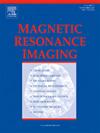IVIM联合DCE-MRI表征乳房x线摄影检测到的建筑畸变:一项试点研究
IF 2
4区 医学
Q2 RADIOLOGY, NUCLEAR MEDICINE & MEDICAL IMAGING
引用次数: 0
摘要
目的探讨体素内非相干运动(IVIM)联合动态对比增强磁共振成像(DCE-MRI)对乳腺x线摄影中结构畸变(AD)改变的诊断价值。方法收集2019年4月至2022年2月期间在乳房x光检查中被诊断为AD变化后接受乳腺MRI检查的患者的数据。应用纳入和排除标准后,最终共有80例患者被纳入本研究。两名独立放射科医生记录DCE-MRI病变特征和IVIM参数。最终结果是通过活检或手术切除的病理结果或至少两年的临床和放射随访来确定的。结果33例(41.25%)患者MRI未检出病变。其余47例(58.75%)患者中,良性病变17例(36.17%),恶性病变30例(63.83%)。本研究纳入的80例患者中,MRI鉴别AD良恶性病变的敏感性、特异性、阴性预测值、阳性预测值分别为100%、92%、100%、88.2%,总体准确率估计为95%。在MRI阳性患者的DCE-MRI特征上,良恶性AD的病变直径、肿块增强的形状和边缘、非肿块增强的分布、内部增强和时间信号强度曲线(TIC)在良恶性AD之间存在显著差异(P < 0.05)。其中,内部增强和TIC被确定为独立的风险预测因子,曲线下面积(AUC)为0.969。在IVIM参数方面,良恶性AD的ADC、D、D*、f值差异均有统计学意义(P < 0.05), AUC值分别为0.908、0.831、0.680、0.761。ADC和D*为独立风险预测因子,合并AUC为0.925。DCE-MRI联合IVIM的AUC最高,达0.984。结论sivim联合DCE-MRI是一种可靠的AD变化分类预测工具,具有较高的诊断效能。此外,患有AD改变的患者的乳腺MRI阴性可用于排除恶性肿瘤。本文章由计算机程序翻译,如有差异,请以英文原文为准。
IVIM combined with DCE-MRI characterize architectural distortion detected on mammography: A pilot study
Objective
To evaluate the diagnostic value of intravoxel incoherent motion (IVIM) combined with dynamic contrast-enhanced magnetic resonance imaging (DCE-MRI) in patients with architectural distortion (AD) changes on mammography.
Methods
Data were collected from patients who underwent breast MRI after being diagnosed with AD changes on mammography between April 2019 and February 2022. After applying the inclusion and exclusion criteria, a total of 80 patients were ultimately included in this study. Two independent radiologists recorded DCE-MRI lesion characteristics and IVIM parameters. The final outcomes were determined using pathology results from biopsy or surgical excision or at least two years of clinical and radiological follow-up.
Results
In 33 (41.25 %) patients, no lesions were detected on MRI. Among the remaining 47 (58.75 %) patients, 17 (36.17 %) had benign lesions, while 30 (63.83 %) had malignant lesions. Among the 80 patients included in the study, the sensitivity, specificity, negative predictive value, and positive predictive value of MRI to distinguish benign and malignant AD changes were 100 %, 92 %, 100 %, and 88.2 %, respectively, and the overall accuracy was estimated to be 95 %. Regarding DCE-MRI characteristics of patients with positive MRI findings, lesion diameter, shape and margin of mass enhancement, distribution of non-mass enhancement, internal enhancement and time signal intensity curve (TIC) exhibited significant differences between benign and malignant AD (P < 0.05). Among these, internal enhancement and TIC were identified as independent risk predictors, with a combined area under curve (AUC) of 0.969. In terms of IVIM parameters, ADC, D, D*, and f values demonstrated significant differences between benign and malignant AD (all P < 0.05), with AUC values of 0.908, 0.831, 0.680, and 0.761, respectively. ADC and D* were identified as independent risk predictors, with a combined AUC of 0.925. Combined DCE-MRI and IVIM provided the highest AUC, reaching 0.984.
Conclusions
IVIM combined with DCE-MRI is a reliable predictive tool for the classification of AD changes with high diagnostic efficacy. Also, a negative breast MRI in patients with AD changes can be used to exclude malignancy.
求助全文
通过发布文献求助,成功后即可免费获取论文全文。
去求助
来源期刊

Magnetic resonance imaging
医学-核医学
CiteScore
4.70
自引率
4.00%
发文量
194
审稿时长
83 days
期刊介绍:
Magnetic Resonance Imaging (MRI) is the first international multidisciplinary journal encompassing physical, life, and clinical science investigations as they relate to the development and use of magnetic resonance imaging. MRI is dedicated to both basic research, technological innovation and applications, providing a single forum for communication among radiologists, physicists, chemists, biochemists, biologists, engineers, internists, pathologists, physiologists, computer scientists, and mathematicians.
 求助内容:
求助内容: 应助结果提醒方式:
应助结果提醒方式:


